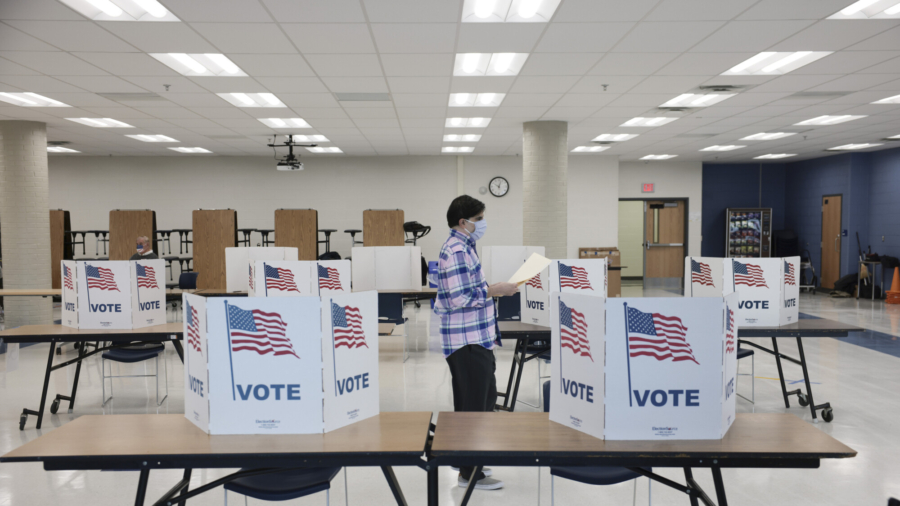A global survey on political stance showed that young people are in despair regarding politics, especially young men, and more are turning towards conservative values.
The Dutch survey from research agency Glocalities combined 300,000 small surveys conducted from 2014 to 2023 in 20 countries, including the United States.
Among other findings, it showed that young men are becoming more disillusioned with politics, shifting increasingly to conservative values and away from the political establishment. The Dutch author presented this trend as concerning and “extreme.”
The survey’s overall measurement was a graph with the vertical axis measuring hope and the horizontal going from conservativism to leftism (the wording was “control” and “freedom,” respectively, in the survey.)
It showed that the same trend is not so apparent in young women, who are more supportive of the current political trends.
On average, the world moved a bit more to the left through these nine years, according to what the survey could measure, even though the degree of change was small.
The author said that the survey could represent 60 percent of the global population. It was conducted in Australia, Belgium, Brazil, Canada, China, France, Germany, India, Italy, Japan, Mexico, the Netherlands, Poland, Russia, South Africa, South Korea, Spain, Turkey, Britain, and the U.S.
Young people the world over feel especially let down by society, said Martijn Lampert, head of research at Glocalities, adding that “the surge in despair among young adults in the U.S. far outweighs the rise in despair among young adults in EU countries.”
Young U.S. men were the only population group in the United States or seven European Union member states to have become more conservative since 2014.
In total, 14,526 Americans were polled between 2014 and 2023, including 2,242 men aged 18-34.
Worldwide, “feelings of hopelessness, societal disillusionment, and rebelling against cosmopolitan values” partly explain the rise of “anti-establishment parties,” Mr. Lampert said, citing elections in several European countries.
In common points, both young men and women were worried about career prospects, financial security, and education.
Men aged 18-24 overtook men aged 55-70 as the most conservative group, while women aged 18-24 grew a bit more leftist.
On a scale where 1 represents the most conservative and 5 the most leftist, the number of women worldwide aged 18-24 increased from 3.55 in 2014 to 3.78 in 2023—both easily the highest for any age group.
Men of the same age moved from 3.29 to 3.36. In the U.S., men 18-34 became less leftist, dropping from 3.48 to 3.46.
Young women were worried above all about social issues such as sexual harassment, domestic violence, child abuse, and neglect.
Young men were more geared toward achieving social and economic status and set store by traditional family values, competition, bravery, and honor.
The world’s men and women over 55 were the only groups to become generally more hopeful over the decade, as well as more leftist.
Respondents were asked 43 questions to assess where they ranked.
To gauge social values, Glocalities assessed their views about gender roles, gender role flexibility, same-sex marriage, and cohabitation before marriage.
The measurement of sentiment focused on future prospects and feelings about being let down by society.
Voter Turnout in the US
The survey was also seen in context of the upcoming U.S. and European Union elections in November and June respectively.
According to the Pew Research Center, 30 percent of the voting-eligible population in the United States did not vote in any of the three elections of 2018, 2020, and 2022.
People who vote intermittently also often determine the final result of an election, given how politically divided the regular voters are, according to Pew.
These three U.S. elections (2018, 2020, and 2022) had the highest turnout in decades.
“About two-thirds (66 percent) of the voting-eligible population turned out for the 2020 presidential election—the highest rate for any national election since 1900,” the Pew survey said.
The 2018 election had a 49 percent turnout, the highest for a midterm election since 1914.
In 2022, the election had a turnout of 46 percent, the highest midterm participation since 1970.
“Overall, 70 percent of U.S. adult citizens who were eligible to participate in all three elections between 2018 and 2022 voted in at least one of them, with about half that share (37 percent) voting in all three,” the Pew survey said.
Race and ethnicity also play a critical role in voting preference, with black and Asian populations voting much more Democrat than Republican, according to the survey. Around 95 percent of blacks voted Democrat, and only 5 percent voted Republican, with Asians voting around 70 percent Democrat and 30 percent Republican.
Reuters contributed to this report.


